Achieving Self-Supported Hierarchical Cu(OH)2/Nickel–Cobalt Sulfide Electrode for Electrochemical Energy Storage
Abstract
:1. Introduction
2. Materials and Methods
2.1. Materials and Reagents
2.2. Electrodeposition of Hierarchical Cu(OH)2/NCS on CF
2.3. Characterization
3. Results
4. Conclusions
Author Contributions
Funding
Data Availability Statement
Conflicts of Interest
References
- Rehman, J.; Eid, K.; Ali, R.; Fan, X.F.; Murtaza, G.; Faizan, M.; Laref, A.; Zheng, W.T.; Varma, G.S. Engineering of Transition Metal Sulfide Nanostructures as Efficient Electrodes for High-Performance Supercapacitors. ACS Appl. Energy Mater. 2022, 5, 6481–6498. [Google Scholar] [CrossRef]
- Miao, Y.D.; Zhang, X.P.; Zhan, J.; Sui, Y.W.; Qi, J.Q.; Wei, F.X.; Meng, Q.K.; He, Y.Z.; Ren, Y.J.; Zhan, Z.Z.; et al. Hierarchical NiS@CoS with Controllable Core-Shell Structure by Two-Step Strategy for Supercapacitor Electrodes. Adv. Mater. Interfaces 2019, 7, 1901618. [Google Scholar] [CrossRef]
- Zheng, L.X.; Song, J.L.; Ye, X.Y.; Wang, Y.Z.; Shi, X.W.; Huajun Zheng, H.J. Construction of self-supported hierarchical NiCo-S nanosheet arrays for supercapacitors with ultrahigh specific capacitance. Nanoscale 2020, 12, 13811–13821. [Google Scholar] [CrossRef] [PubMed]
- Ma, F.; Dai, X.Q.; Jin, J.; Tie, N.; Dai, Y.T. Hierarchical core-shell hollow CoMoS4@Ni-Co-S nanotubes hybrid arrays as advanced electrode material for supercapacitors. Electrochim. Acta 2020, 331, 135459. [Google Scholar] [CrossRef]
- Tauquir, S.M.; Karnan, M.; Subramani, K.; Sathish, M. One-step superficial electrodeposition of nickel-cobalt-sulfide for high-energy hybrid asymmetric supercapacitor. Mater. Lett. 2022, 323, 132563. [Google Scholar] [CrossRef]
- Chen, C.; Yan, D.; Luo, X.; Gao, W.J.; Huang, G.J.; Han, Z.W.; Zeng, Y.; Zhu, Z.H. Construction of Core-Shell NiMoO4@Ni-Co-S Nanorods as Advanced Electrodes for High-Performance Asymmetric Supercapacitors. ACS Appl. Mater. Interfaces 2018, 10, 4662–4671. [Google Scholar] [CrossRef]
- Wang, Y.; Yin, Z.L.; Wang, Z.X.; Li, X.H.; Guo, H.J.; Wang, J.X.; Zhang, D.C. Facile construction of Co(OH)2@Ni(OH)2 core-shell nanosheets on nickel foam as three dimensional free-standing electrode for supercapacitors. Electrochim. Acta 2019, 293, 40–46. [Google Scholar] [CrossRef]
- He, D.; Wan, G.D.; Liu, G.L.; Bai, J.H.; Suo, H.; Zhao, C. Facile route to achieve mesoporous Cu(OH)2 nanorods on copper foam for high-performance supercapacitor electrode. J. Alloys Compd. 2017, 699, 706–712. [Google Scholar] [CrossRef]
- Wen, Y.X.; Liu, Y.P.; Wang, T.; Wang, Z.L.; Zhang, Y.Z.; Wu, X.G.; Chen, X.T.; Peng, S.L.; He, D.Y. High-Mass-Loading Ni-Co-S Electrodes with Unfading Electrochemical Performance for Supercapacitors. ACS Appl. Energy Mater. 2021, 4, 6531–6541. [Google Scholar] [CrossRef]
- Wang, J.S.; Hu, L.B.; Zhou, X.Y.; Zhang, S.; Qiao, Q.S.; Xu, L.; Tang, S.C. Three-Dimensional Porous Network Electrodes with Cu(OH)2 Nanosheet/Ni3S2 Nanowire 2D/1D Heterostructures for Remarkably Cycle-Stable Supercapacitors. ACS Omega 2021, 6, 34276–34285. [Google Scholar] [CrossRef]
- Wang, X.M.; Deng, Y.Y.; Wang, Z.H.; Li, Z.W.; Wang, L.C.; Ouyang, J.; Zhou, C.; Luo, Y.F. Sophora-like Nickel-Cobalt Sulfide and Carbon Nanotube Composites in Carbonized Wood Slice Electrodes for All-Solid-State Supercapacitors. ACS Appl. Energy Mater. 2022, 5, 7400–7407. [Google Scholar] [CrossRef]
- Maile, N.C.; Shinde, S.K.; Koli, R.R.; Fulari, A.V.; Kim, D.Y.; Fulari, V.J. Effect of different electrolytes and deposition time on the supercapacitor properties of nanoflflake-like Co(OH)2 electrodes. Ultrason. Sonochem. 2019, 51, 49–57. [Google Scholar] [CrossRef] [PubMed]
- Gao, Y.; Zhao, L.J. Review on recent advances in nanostructured transition-metal-sulfide-based electrode materials for cathode materials of asymmetric supercapacitors. Chem. Eng. J. 2022, 430, 132745–132763. [Google Scholar] [CrossRef]
- Miller, E.E.; Hua, Y.; Tezel, F.H. Materials for energy storage: Review of electrode materials and methods of increasing capacitance for supercapacitors. J. Energy Storage 2018, 20, 30–40. [Google Scholar] [CrossRef]
- Yu, K.; Tang, W.M.; Dai, J.Y. Double-Layer MnCo2S4@Ni-Co-S Core/Shell Nanostructure on Nickel Foam for High-Performance Supercapacitor. Phys. Status Solidi A 2018, 215, 1800147. [Google Scholar]
- Dai, M.Z.; Zhao, D.P.; Liu, H.Q.; Zhu, X.F.; Wu, X.; Wang, B. Nanohybridization of Ni-Co-S Nanosheets with ZnCo2O4 Nanowires as Supercapacitor Electrodes with Long Cycling Stabilities. ACS Appl. Energy Mater. 2021, 4, 2637–2643. [Google Scholar]
- Satpathy, B.K.; Patnaik, S.; Pradhan, D. Room-Temperature Growth of Co(OH)2 Nanosheets on Nanobelt-like Cu(OH)2 Arrays for a Binder-Free High-Performance All-Solid-State Supercapacitor. ACS Appl. Energy Mater. 2022, 1, 77–87. [Google Scholar] [CrossRef]
- Tang, S.S.; Li, X.G.; Courté, M.; Peng, J.J.; Fichou, D. Hierarchical Cu(OH)2@Co(OH)2 Nanotrees for Water Oxidation Electrolysis. ChemCatChem 2020, 12, 4038–4043. [Google Scholar] [CrossRef]
- Pu, X.L.; Ren, X.H.; Yin, H.F.; Tang, Y.; Yuan, H.D. One-step electrodeposition strategy for growing nickel cobalt hydroxysulfide nanosheets for supercapacitor application. J. Alloys Compd. 2021, 865, 158736. [Google Scholar] [CrossRef]
- Fu, S.Q.; Yang, X.C.; Zhao, P.D.; Yao, X.; Jiao, Z.; Cheng, L.L. Regulable Electron Transfer on ZnS/CoS2/CC Prepared by an MOF-on-MOF Strategy for Robust LIB Performance. ACS Appl. Energy Mater. 2022, 5, 5159–5169. [Google Scholar] [CrossRef]
- Lin, Y.F.; Chen, X.Y.; Chang, P.; Liu, Z.L.; Ren, G.H.; Tao, J.G. Hierarchical design of Ni3S2@Co9S8 nanotubes for supercapacitors with long cycle-life and high energy density. J. Alloys Compd. 2022, 900, 163503. [Google Scholar] [CrossRef]
- Li, R.; Wang, S.L.; Huang, Z.C.; Lu, F.X.; He, T.B. NiCo2S4@Co(OH)2 core-shell nanotube arrays in situ grown on Ni foam for high performances asymmetric supercapcitors. J. Power Sources 2016, 312, 156–164. [Google Scholar] [CrossRef]
- Liu, G.L.; Zhao, C.; Liu, T.Y.; He, D.; Suo, H. Facile route to achieve book-like tricobalt tetraoxide microstructures on copper foam for high performance supercapacitor. Mater. Lett. 2018, 220, 78–81. [Google Scholar] [CrossRef]
- Zhu, D.; Yan, M.L.; Chen, R.R.; Liu, Q.; Liu, J.Y.; Yu, J.; Zhang, H.S.; Zhang, M.L.; Liu, P.L.; Junqing Li, J.Q.; et al. 3D Cu(OH)2 nanowires/carbon cloth for flexible supercapacitors with outstanding cycle stability. Chem. Eng. J. 2019, 371, 348–355. [Google Scholar] [CrossRef]
- Meng, Y.; Sun, P.X.; He, W.D.; Teng, B.; Xu, X.J. Construction of Hierarchical Co-Ni-S Nanosheets as Free-Standing Electrode for Superior-Performance Asymmetric Supercapacitors. Appl. Surf. Sci. 2019, 470, 792–799. [Google Scholar] [CrossRef]
- Wang, H.N.; Yan, G.W.; Cao, X.Y.; Liu, Y.; Zhong, Y.X.; Cui, L.; Liu, J.Q. Hierarchical Cu(OH)2@MnO2 core-shell nanorods array in situ generated on three-dimensional copper foam for high-performance supercapacitors. J. Colloid Interface Sci. 2020, 563, 394–404. [Google Scholar] [CrossRef]
- Yu, Y.W.; Wang, H.M.; Zhang, H.Z.; Tan, Y.R.; Wang, Y.L.; Song, K.F.; Yang, B.Q.; Yuan, L.F.; Shen, X.D.; Hu, X.L. Blanket-like Co(OH)2/CoOOH/Co3O4/Cu(OH)2 composites on Cu foam for hybrid supercapacitor. Electrochim. Acta 2020, 334, 135559. [Google Scholar] [CrossRef]
- Fu, H.C.; Zhang, A.T.; Jin, F.H.; Guo, H.W.; Huang, W.J.; Cheng, W.T.; Jingquan Liu, J.Q. Origami and layered-shaped ZnNiFe-LDH synthesized on Cu(OH)2 nanorods array to enhance the energy storage capability. J. Colloid Interface Sci. 2022, 607, 1269–1279. [Google Scholar] [CrossRef]
- Zhang, G.L.; Zhu, R.F.; Zhang, R.Q.; Zhang, D.; Sun, C.; Long, Z.; Li, Y.N. 3D hetero-nanostructured electrode constructed on carbon fiber paper with 2D 1T-MoS2/1D Cu(OH)2 for flexible asymmetric solid-state supercapacitors. J. Power Sources 2022, 523, 231031. [Google Scholar] [CrossRef]
- Hu, X.M.; Liu, S.C.; Chen, Y.K.; Jiang, J.B.; Cong, H.S.; Tang, J.B.; Sun, Y.X.; Han, S.; Lin, H.L. Rational design of flower-like cobalt-manganese-sulfide nanosheets for high performance supercapacitor electrode materials. New J. Chem. 2020, 44, 11786–11795. [Google Scholar] [CrossRef]

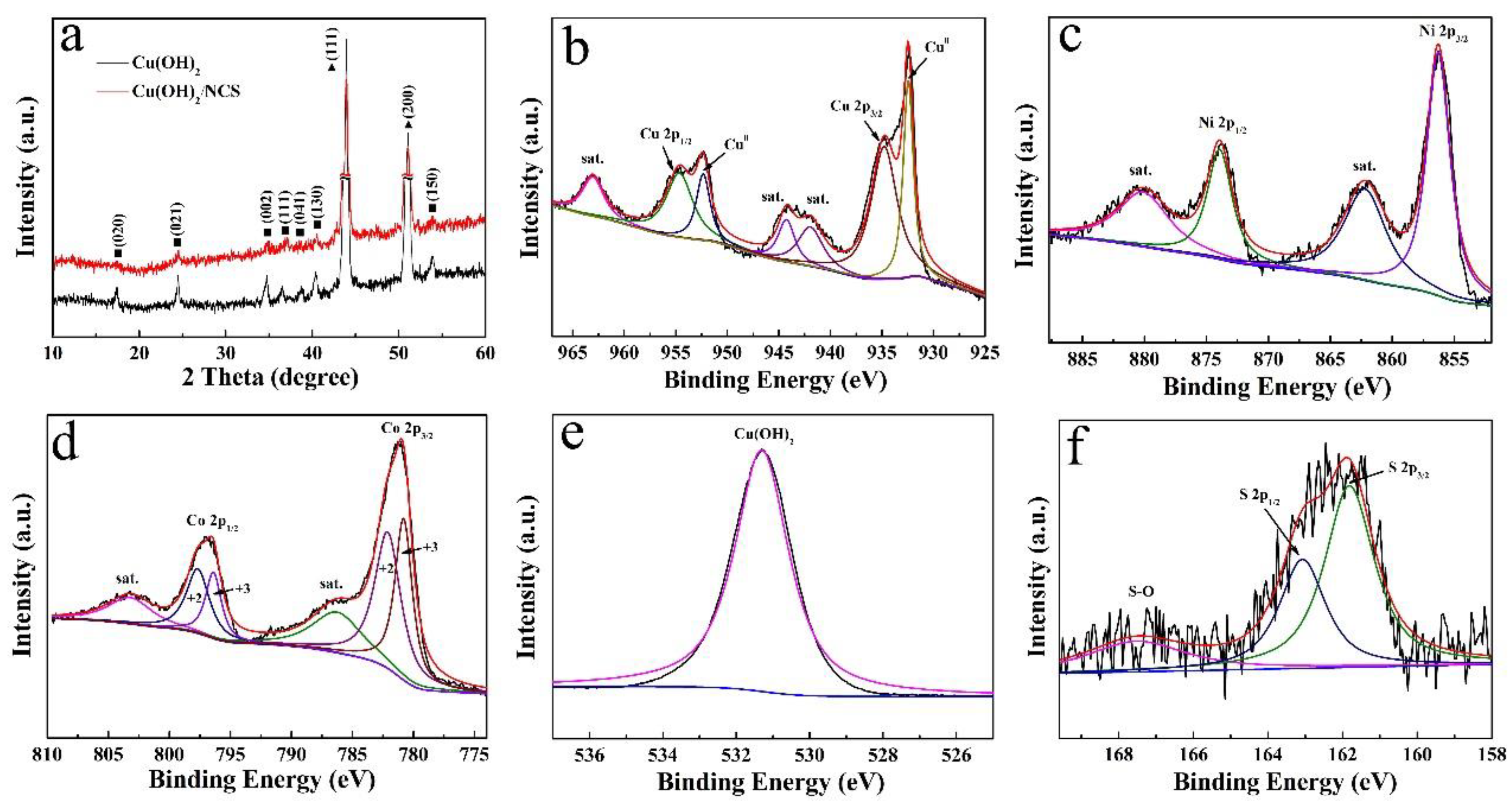
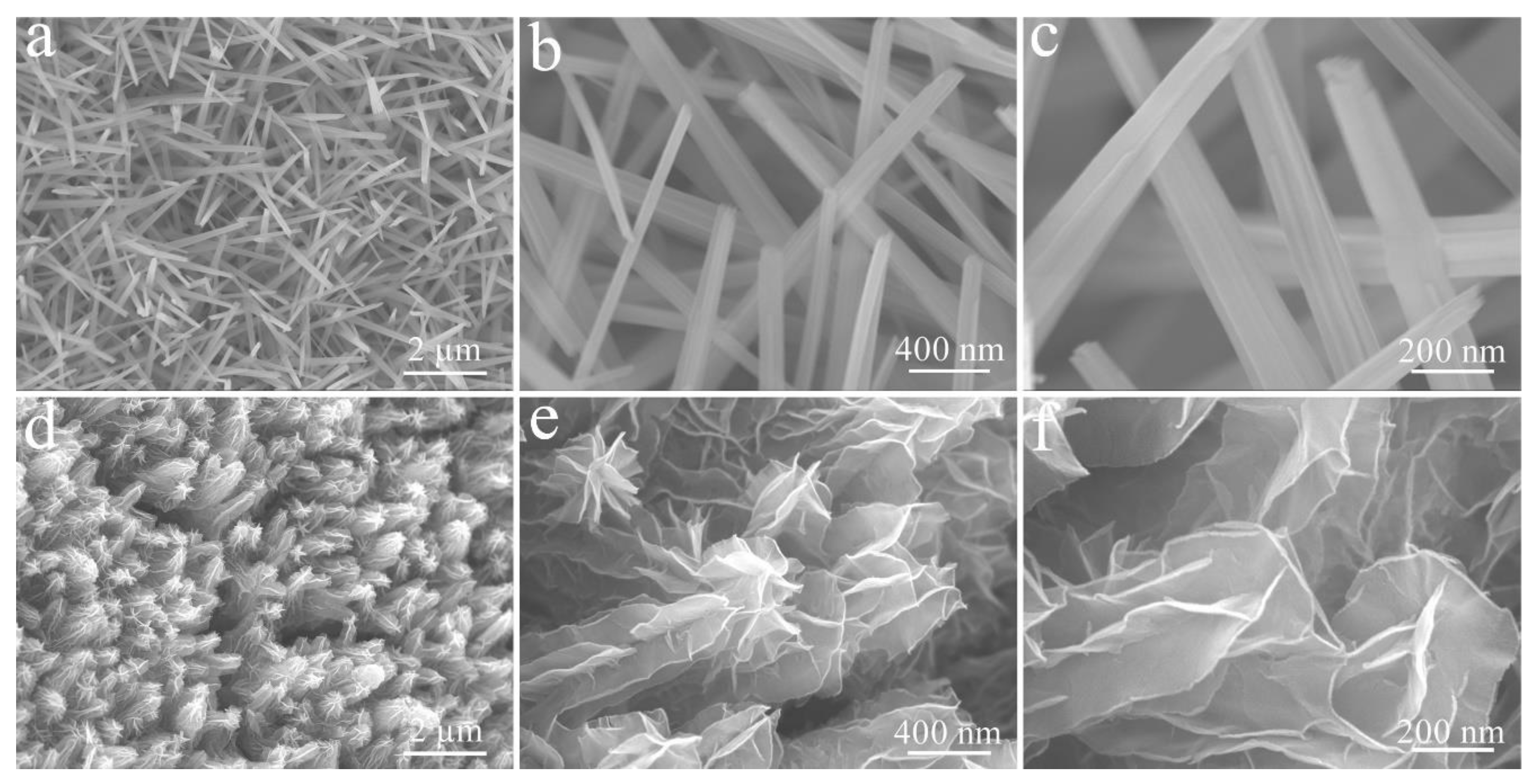
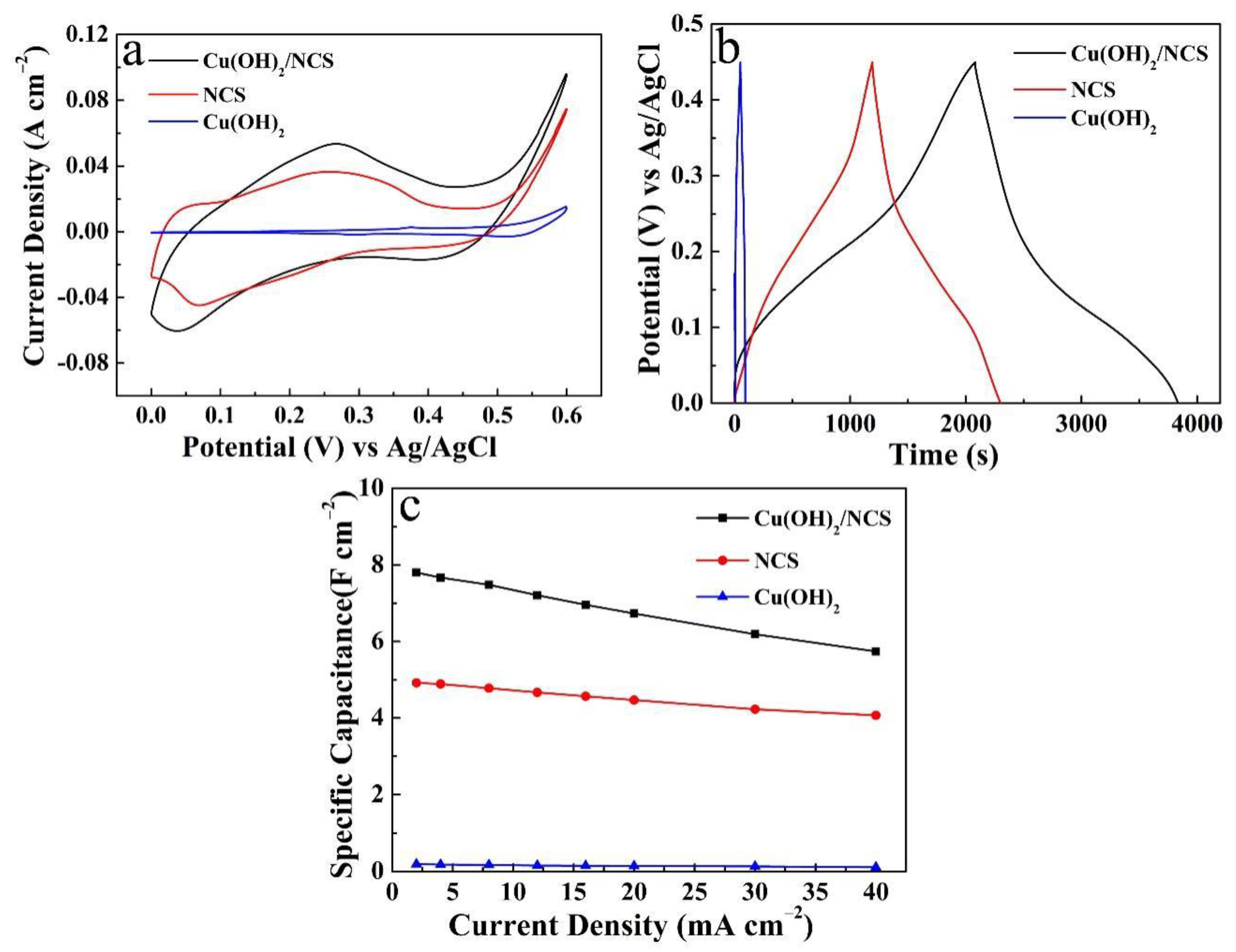
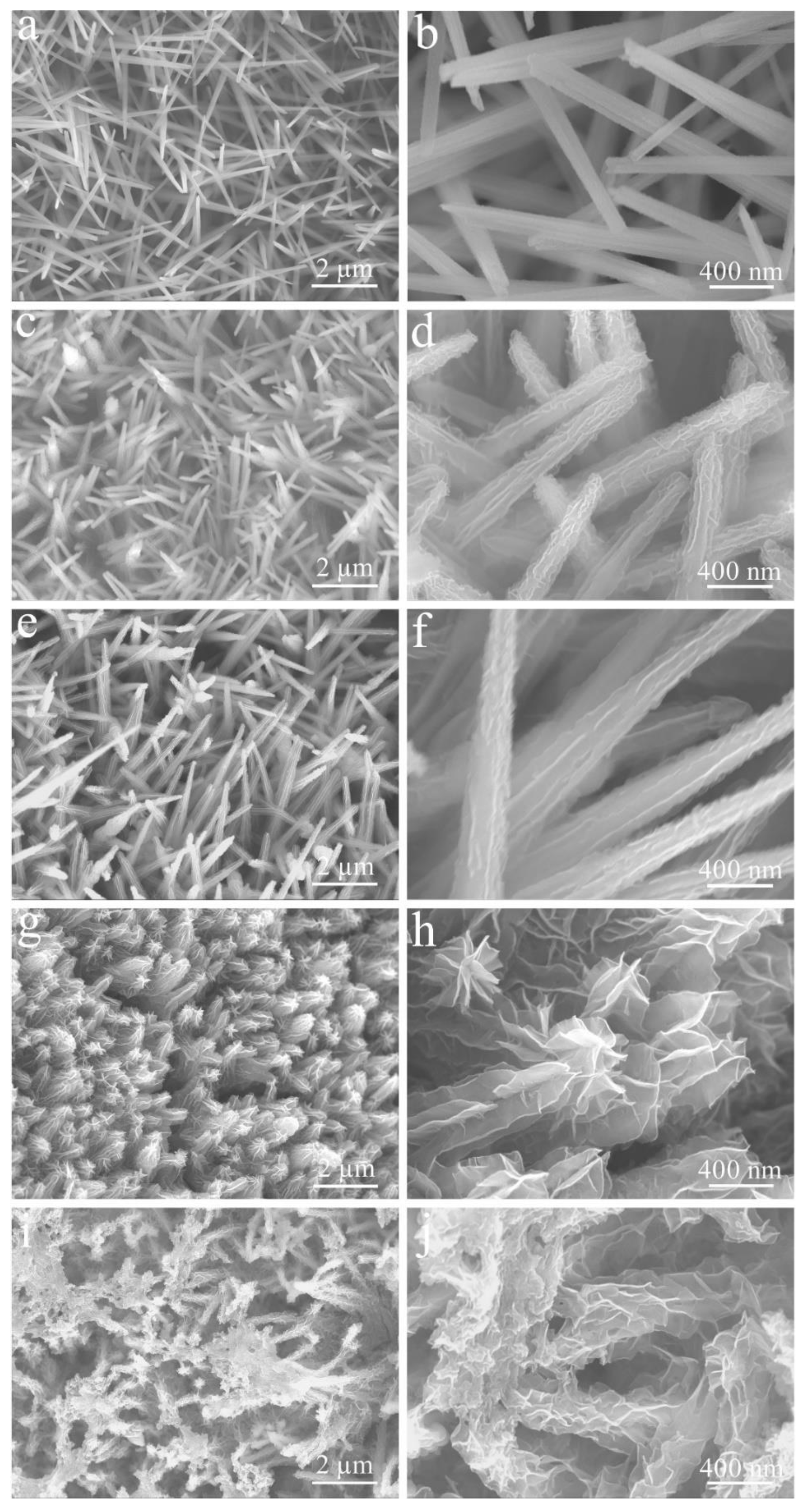
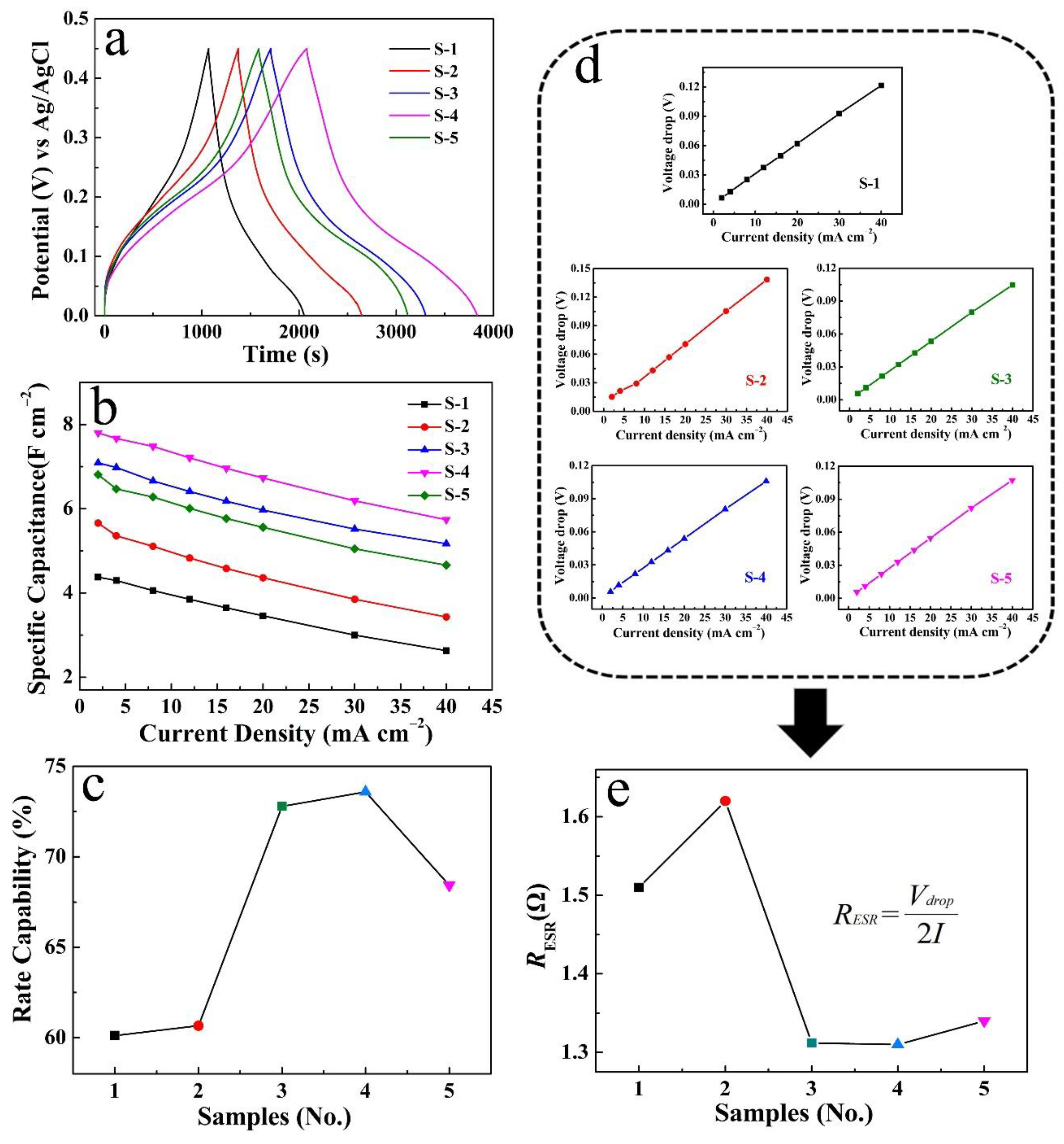
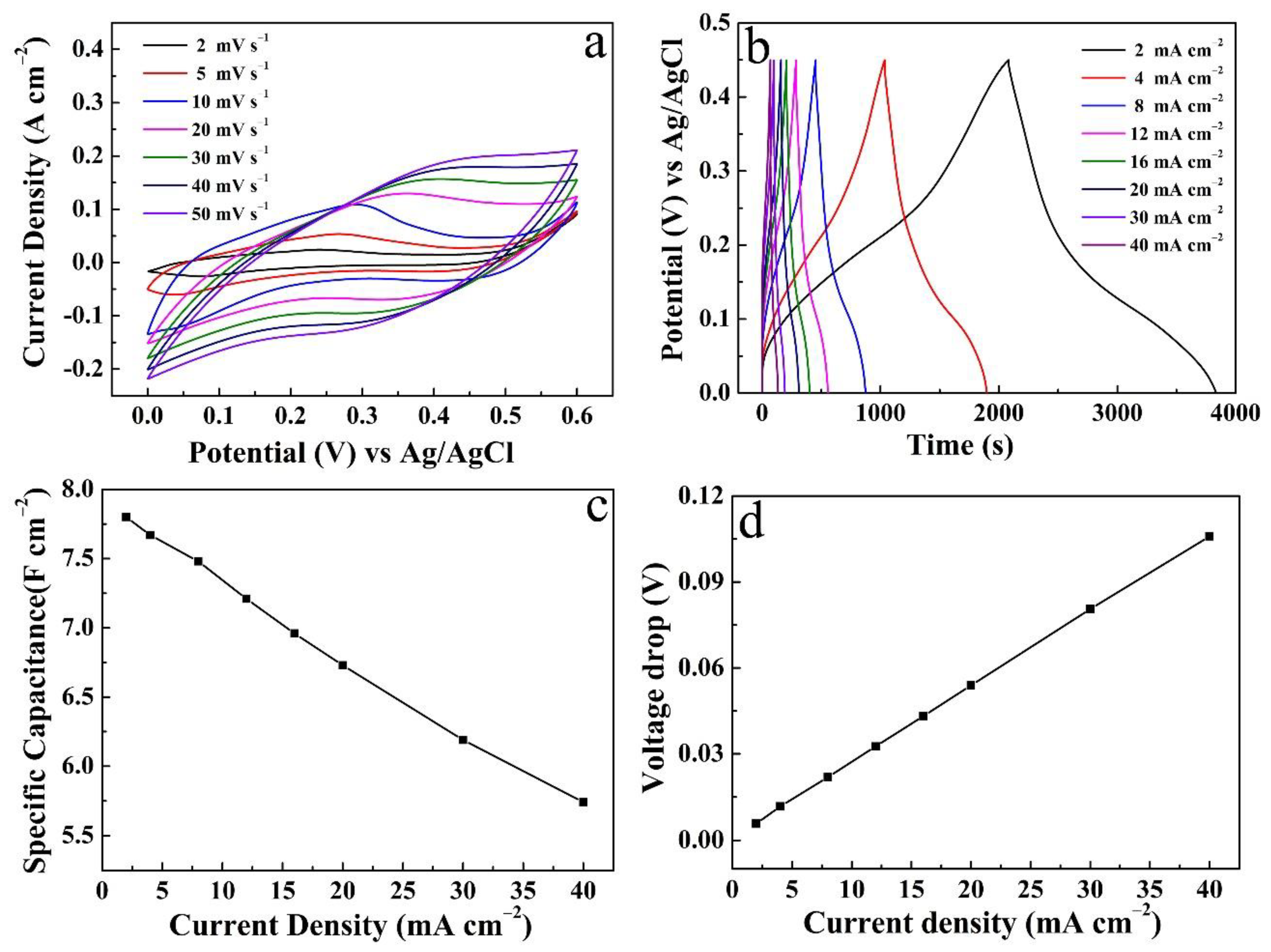
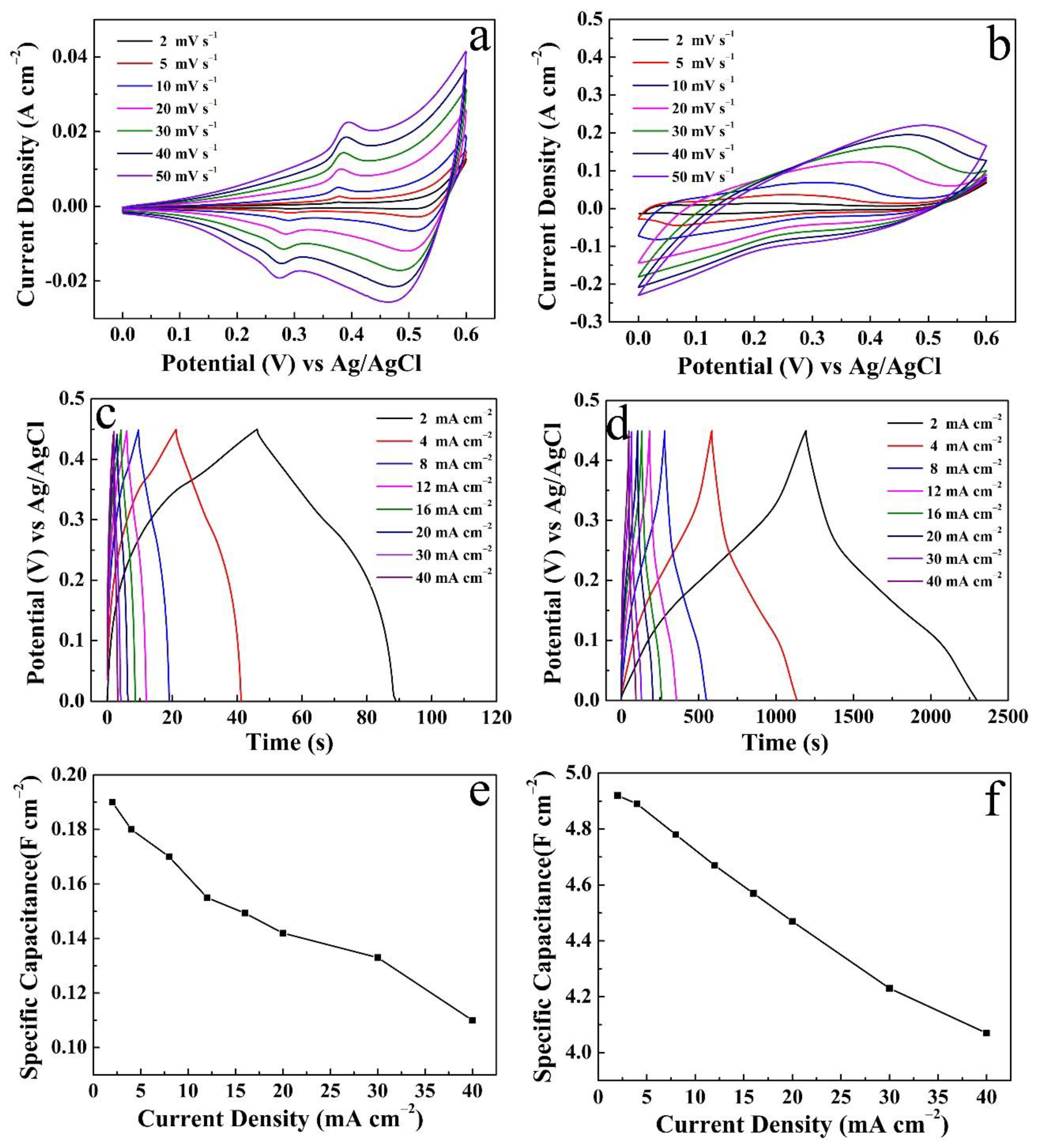
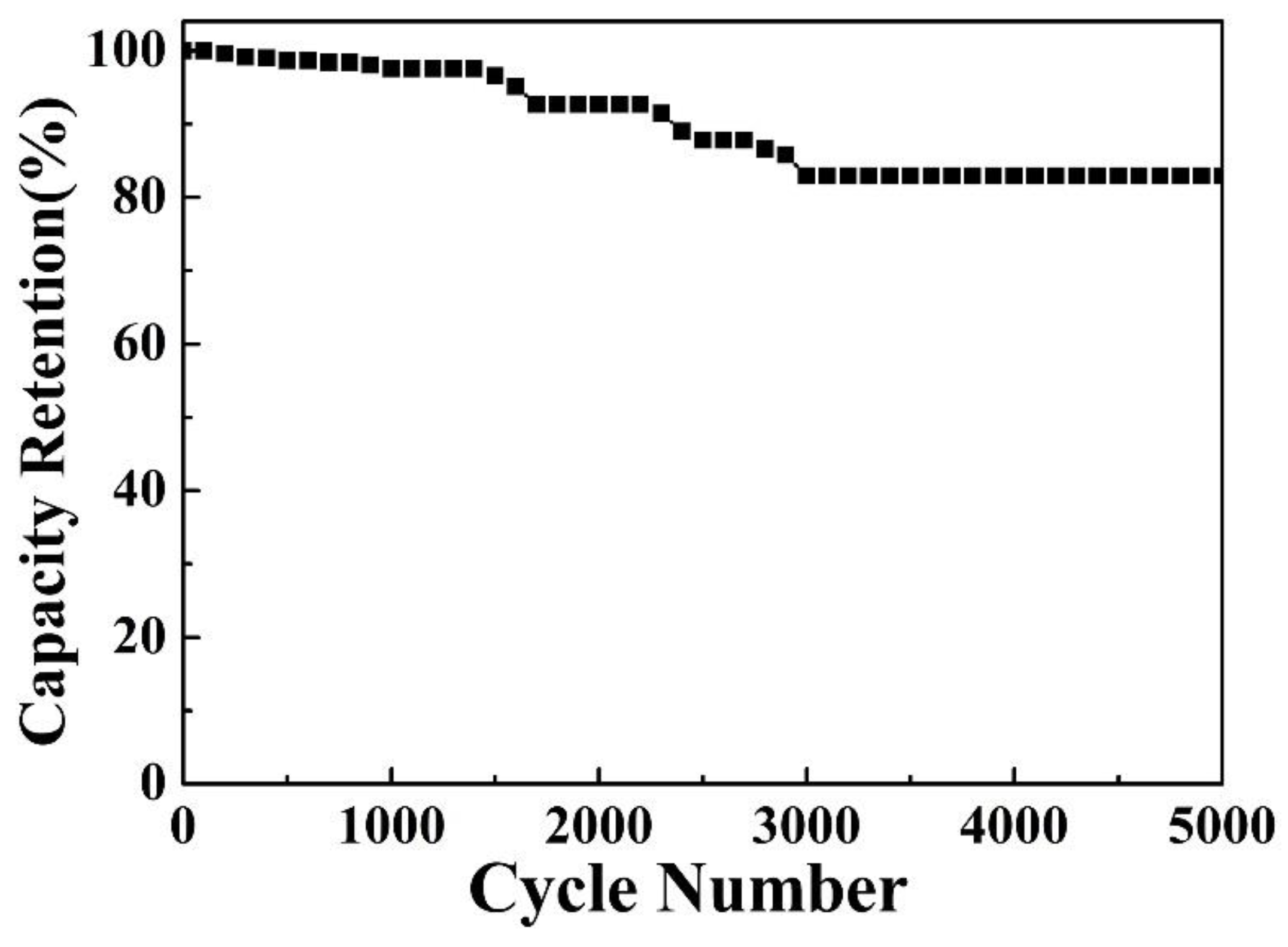
| Active Material | Substrate | Electrolyte | Current Density (mA cm−2) | Cs (F cm−2) | Refs. |
|---|---|---|---|---|---|
| Cu(OH)2 | Carbon cloth | 1 M NaOH | 1 | 0.24 | [24] |
| Cu(OH)2 | Cu foam | 5 M NaOH | 2 | 1.75 | [8] |
| Co-Ni-S | Ni foam | 3 M KOH | 1 | 6.30 | [25] |
| Cu(OH)2@MnO2 | Cu foam | 6 M KOH | 2 | 0.71 | [26] |
| Co(OH)2/CoOOH/ Co3O4/Cu(OH)2 | Cu foam | 1 M KOH | 1 | 1.94 | [27] |
| ZnNiFe-LDH/Cu(OH)2 | Cu foam | 6 M KOH | 3 | 6.1 | [28] |
| MoS2/Cu(OH)2 | Carbon fiber paper | 6 M KOH | 1 | 1.12 | [29] |
| NiMoO4@Ni-Co-S | Ni foam | 2 M KOH | 5 | 2.27 | [6] |
| Cu(OH)2/Ni-Co-S | Cu foam | 2 M NaOH | 2 | 7.80 | this work |
Disclaimer/Publisher’s Note: The statements, opinions and data contained in all publications are solely those of the individual author(s) and contributor(s) and not of MDPI and/or the editor(s). MDPI and/or the editor(s) disclaim responsibility for any injury to people or property resulting from any ideas, methods, instructions or products referred to in the content. |
© 2023 by the authors. Licensee MDPI, Basel, Switzerland. This article is an open access article distributed under the terms and conditions of the Creative Commons Attribution (CC BY) license (https://creativecommons.org/licenses/by/4.0/).
Share and Cite
Lv, S.; Shang, W.; Chi, Y.; Wang, H.; Chu, X.; Wu, B.; Geng, P.; Wang, C.; Yang, J.; Cheng, Z.; et al. Achieving Self-Supported Hierarchical Cu(OH)2/Nickel–Cobalt Sulfide Electrode for Electrochemical Energy Storage. Micromachines 2023, 14, 125. https://doi.org/10.3390/mi14010125
Lv S, Shang W, Chi Y, Wang H, Chu X, Wu B, Geng P, Wang C, Yang J, Cheng Z, et al. Achieving Self-Supported Hierarchical Cu(OH)2/Nickel–Cobalt Sulfide Electrode for Electrochemical Energy Storage. Micromachines. 2023; 14(1):125. https://doi.org/10.3390/mi14010125
Chicago/Turabian StyleLv, Sa, Wenshi Shang, Yaodan Chi, Huan Wang, Xuefeng Chu, Boqi Wu, Peiyu Geng, Chao Wang, Jia Yang, Zhifei Cheng, and et al. 2023. "Achieving Self-Supported Hierarchical Cu(OH)2/Nickel–Cobalt Sulfide Electrode for Electrochemical Energy Storage" Micromachines 14, no. 1: 125. https://doi.org/10.3390/mi14010125
APA StyleLv, S., Shang, W., Chi, Y., Wang, H., Chu, X., Wu, B., Geng, P., Wang, C., Yang, J., Cheng, Z., & Yang, X. (2023). Achieving Self-Supported Hierarchical Cu(OH)2/Nickel–Cobalt Sulfide Electrode for Electrochemical Energy Storage. Micromachines, 14(1), 125. https://doi.org/10.3390/mi14010125





